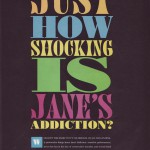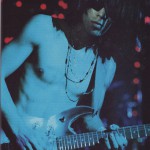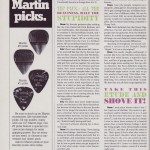“Just How Shocking is Jane’s Addiction?”
Guitar Player
March 1991
by Joe Gore
pg 73-77Wouldn’t you know it? It’s the Breaths. Of all the genuinely provocative things about Jane’s Addiction – anarchic performances, lyrics that fart in the face of conservative morality, and several band members unapologetic histories of heroin use, for starters – its the bare breasted sculptures on the L.A. quartet’s two Warner Bros. albums – 1988’s Nothings Shocking and last year’s Ritual De Lo Habitual – that caused the biggest stir.
Several retailers refused to stock the records, and the band members found themselves willing spokespersons for the anti-censorship cause. Meanwhile, Jane’s Addiction blossomed from underground critical darlings to mainstream sensations, selling tons of records to a fanatical youth following seemingly burned out on formula video-pop.
Would any of this matter if the band didn’t make music as momentous as their hype? No telling, because Shocking and Ritual are ridiculously good records, joyous train wrecks of high-concept artsiness and low-down psycho-metallic grunge. Both recapture the free form spontaneity of classic 1960’s rock without ever sounding merely retro. They reek of a funky danger not sniffed since the Stones, Doors and Velvet Underground were in full flower.
The groups early reputation was based in its shows (their debut album, Jane’s Addiction [Triple X], was recorded live), but the band understands that creating records means more than capturing energy on tape. Shocking and Ritual are sonic miracles, elaborately detailed productions with a sound that emanates from neither the garage nor the corporate boardroom. They’re larger than-life recordings, powered by heart-stopping dynamic contrasts and deep, narcotic mixes. David Navarro’s unscalable walls of overdubbed guitars, the brontosaurus-weight rhythm section work of bassist Eric Avery and drummer Stephen Perkins, and the haunting falsetto vocals of bandleader Perry Farrell have, with some justification, caused many to compare Jane’s Addiction to Led Zeppelin.
Jane’s Addiction is the first prominent band for both Navarro and Avery. Eric, 25 has been collaborating with Farrell since 1985; Dave, 23, signed on a year later. The two are extremely unpretentious and soft-spoken, and both insist that they almost never listen to rock music.
Dave, you do wonderful things with overdubs.
Dave: You think so? I generally go into the studio not knowing what I’m going to do, though I know the basic song. I throw down a bunch of stuff. If it works, great; if not, scratch it. We do the basic tracks, all four of us live, then I do a rhythm part to double or match the basic. After that if I hear a space that can use something, I put it in. If I don’t like it, I try something else. But I don’t spend too much time – the solo on “Three Days” [Ritual] was a first take, the rough track. Anyone the least bit creative could spend forever in the studio, and I don’t want to take our budget out the window.
We pay a lot of attention to tones and sounds. When I introduce a sound, I like to give your ear something new – not to underplay the previous sound, I used to be more into solo’s, but now I’m more interested in the song. Not every song needs a solo. “Then She Did…” is my favorite track on the latest album. What Perry’s singing about is beautiful and I didn’t want to step on anything.
Eric: “Then She Did..” started as a conscious idea to have a song that was stripped bare, without jazz fusion changes all over the place. We found that we could change the song with dynamics and very subtle changes without having to alter the chord progressions. Or take the song “Whores” [Jane’s Addiction]: The bass line stays in B the entire time; we just used dynamics to make the verse different from the chorus. It’s more of a primitive thing. No, that’s too pretentious – more of a core thing.
I don’t really listen with my left brain. I have to play a line over and over exactly the same way for a good ten minutes before I can decide whether I like it. I’m looking for a feeling rather than a sound. My lines start out with what comes naturally, then I strip away whatever I can, trying to do something interesting. I think “uncomplicated” and “interesting” are almost invariably synonymous.
Trinkets & Knickknacks
Dave: When I listen to records by Hendrix or Jimmy Page – albums I’ve known my whole life – I always hear something new. I like that, and I like the fact that there are things on our records that people won’t hear at first, or even by the hundredth time. For example, on “Idiots Rule” [Shocking], there’s a track of just wah-wah – no notes, just the muted strings. You can barely hear it, but it adds texture and opens things up a bit. And “Been Caught Stealing” [Ritual] has a jangly sound that comes in a few bars after the dirty guitar part. It’s three tracks of electric guitar unplugged – just a mike on the strings. It’s a completely cool sound.
I see music. For me, every color in the rainbow comes out of our songs. I think we’re really colorful.
Did the band consciously adopt a different production approach for Ritual?
Eric: Not going into it, but the nature of the songs demanded that. The record is a lot loonier, more complicated. There are more changes, more trinkets and knickknacks. It’s much more a studio album than our previous records, rather than an attempt to capture what we do live.
Dave: Our shows and our albums are completely different. Live, I never try and duplicate the record, and I never try to record something I did live. But there’s spontaneity to both. Even though this last album is very “produced,” we are a pretty raw band. Mistakes that a lot of retentive guitar players tend to point out, I like. I don’t want things getting too polished. If I like a part that’s fucked up in spots, I keep it. Fucked is good – it’s human.
Eric: The songs on the first two records were written by jamming, and many of the tunes started from a bass line. But Ritual was written mostly by Perry – it just came down that way, because we’ve been spending a lot less time in the same room together. He’d come in with a basic chord progression, humming the riffs. Then we’d get a bass line, then David would work the guitar over it. A song may be going in a certain direction, but a mistake can happen, and we’ll say, “Wait – that works better.” An example is the slow break in “Stop” [Ritual]: initially it was an E groove, but once I played a G instead, and it eventually became a change from E to G.
Zep Plus: All The Heaviness, Half the Stupidity
Dave: My favorite guitarists play nothing like me. Like Daniel Ash from Bauhaus and Love and Rockets – he’s amazing, but he never overdoes it. He has brilliant sounds, and I really respect that. You’d never hear him playing some Yngwie riff on a pretty song. Robert Smith from the Cure is a brilliant player. He’s no technical wizard, but who say’s you have to be to make great art?
Eric: When I was a little stoner kid, I was into Yes and stuff like that. But by the time I got my own bass, I was into Echo and the Bunnymen and Joy Division. Our interest in the Velvet Underground and Joy Division is what initially got Perry and me together. My own bass hero is Peter Hook [of Joy Division and New Order] but I never wanted to play like him. That’s the big mistake people make – mimicking their influences, instead of taking their perspective and doing something different in their own voice. That’s why so many bands are cookie-mold repetitions of each other. As a band we never wanted to sound like them – we just wanted to have the same substance. Also, one of what we do is coming directly from the blues, either, thankfully enough.
Thankfully?
Eric: The blues have never really interested me, not because of the blues themselves, but because of what they’ve become decades later. It’s no longer the emotion of the blues, just a structure. Never once have I played a standard blues bass line. It’s old. If you want to play the blues, play them. But in rock music, I think it’s really boring and tired.
But much of Dave’s playing has a blues/rock tinge?
Dave: It’s a love/hate thing. I love playing blues based things – that’s how I learned, listening to Hendrix albums and stuff. But it’s so overdone, and sometimes it just sounds dorky. It’s fun when you’re jamming around, but it’s not so good when you get trapped into it. But what works, what doesn’t, we’ll live with.
Many have compared Jane’s Addiction to Led Zeppelin.
Eric: It’s inevitable – they were one of the hugest bands in history, and no matter what you think of them, you’re familiar with their music. Zeppelin had interesting music but moronic lyrics. It’s nice to have some intelligence, instead of having the singer going on about fairies, wizards, and squeezing his lemons.
Dave: I see why people compare us to Zeppelin, although it’s frustrating at times. We’ve got a strong front guy, a brilliant drummer, and a lot of different sides. We can be pretty or loud. Still, we never dreamed that anyone would ever compare us to Led Zeppelin. But it’s better than being compared to Cheap Trick.
Eric: David definitely has that Jimmy Page influence, but he’s also been influenced by people like the guitarists from the Butthole Surfers. It’s a really incongruous combination of things – he can’t help but create something interesting from those polar differences.
Speaking of incongruity, you’ve just completed a version of the Grateful Dead’s “Ripple.” Is it true to the original?
Dave: Not exactly [laughs maliciously]. It sounds like Love and Rockets meets Sonic Youth with tribal drums, a repetitive bass line, and lots of grunge guitar. There are effected single notes soaring over the top with no direction. But Perry definitely sings the original melody. And there’s something Deadheads might notice: at the end, we go into another Dead song,”The Other One,” and I through in a riff from Jerry Garcia’s “The Bird Song.” It’s a tribute to the Dead – I really like how they mix all their songs together live.
Take This Etude And Shove It!
Dave: I took piano lessons when I was 7, but I quit out of rebellion. My cousin is a guitar player, and he charted out D, A, C, E, and G at the first three frets for me when I was about 12, and that was pretty much of it, except I went to about three sessions of classical guitar class at Santa Monica College. I don’t like being taught. I hear all these people coming out of G.I.T., and they all sound the same to me. That’s great if that’s what they want to be – I just don’t. Besides, when you don’t know what to do, you can come up with something no one’s ever done because they’d never dream of it. Listen to a three year old bang around on a piano – some of it sounds really cool.
When I was young I practiced all the time – my parents went crazy. I had a band called South Dakota Railroad when I was 12, the worst thing you could imagine. But now I never, ever practice, except to strum a little acoustic. As far as going over scales or getting my hands in shape, I never do that because we play so much.
I used Gibson Les Pauls for most of Nothing’s Shocking, plus a Kramer. But I don’t remember everything because I was in a drug haze at the time. I’ve pawned and rented so many guitars that I never really paid attention to that stuff. Tonight I’m going to play, “Jane Says” on an acoustic. It’s blue with a pickup, EQ, and cutaway, but I have no idea what make it is – I’ve never looked.
My two current main guitars were custom built by Ibanez, and I used them for most of Ritual. Most of their guitars are real metal-looking, so I had them round off the pointy edges. They’re painted with the Nothing’s Shocking album cover. One has a strat body and a Les Paul pickup configuration, because I like having the rhythm/treble toggle switch at the top. I also like having two volume knobs so I can set different levels – I’d rather do it from the guitar than a footswitch. The second guitar has a body with the top half modeled after a Telecaster but the bottom like a Les Paul cutaway. It has a hum/sing/hum pickup configuration and a 5-way switch. The pickups are ultrasonics. My amps are the New Marshall 900’s. The gain sensitivity on one channel goes all the way to 20, and that’s great because I love saturation and sustain. I play through two Marshall 4×12 cabinets. My strings are light – I don’t know the brand – and my picks are fender mediums. I play through a [Dunlop] Cry-Baby wah-wah, and Boss pedals, a DS-1 distortion, a chorus, and a pitch shifter/delay.
Eric: I got my first bass when I was 17, the Fender Precision I play today. I just can’t play any other. I’ve had endorsement offers, but I can’t part with it – it’s like a teddy bear attachment. I have a backup Precision, but I only use it in times of dire emergency.
I used a Trace-Elliot amp for a long time. I got a great sound, but the amp was just too delicate. Now I’m getting some Ampeg SVT2’s with two cabinets, one 8×10 one 2×15. I like a sound without many mids – I slant the equalizer from a big bottom to a small top, but with the very highest bands as high as they’ll go for the clicky pick noise. I usually use a Fender Heavy pick, but not always. The end of “Ted, Just Admit It” [Shocking] gets really violent and unstructured, and I slap – not like funk guys do, just for the brighter, more violent sound. No precision, just angry.
I’ve always tried to avoid the luxury of relying on effects to make things interesting. It makes me work harder, I think. I sometimes play through effects at rehearsal, but I worry that I’ll get lazy, and not pay enough attention to the substance so I don’t use any live.
Dave: I love echo – its the greatest mask a guitar player can have.
To cover yourself up, or transform you?
Dave: Both. It can makes something boring really interesting, and it can cover up a lot of shit. Perry uses a lot of echo on his vocals, too. It adds tension. On the breakdown of “Then She Did…,” I improvised with my echo set on infinite repeats. You get this eerie feeling, but you can’t really hear it. It’s very quiet – I wanted you to feel uncomfortable and not know why. And live, I play with a vibrator.
So does Reeves Gabrels of Tin Machine.
Dave: You’re kidding – don’t tell me someone else does that! Fuck!
Hope I didn’t ruin your day?
Dave: No, it was ruined long before I spoke to you. See, I brought a vibrator for my girlfriend in a sex shop in New Orleans on the way to a sound check. I was showing it to somebody – “Look what I bought!” – and I turned it on about a foot away from the pickup. It went “Neeeowrr!” It was the coolest thing I ever heard. I Velcro it to the side of my amp and use it for “Ted, Just Admit It” waving it all over the pickups with the echo and wah going. Electric shavers, eggbeaters, and shears also come off really cool.
Ignore The Mosquitos
Dave: We just did what we wanted to do, regardless of what anyone told us. When we signed with Warner Bros. we kept all creative control. That’s so important when you sign! Sure, a lot of bands need production help and don’t know how to dress. But we know what we are a lot better than some guy in an office does. Stay true to yourself.
Eric: Just keep a bead of what you want to do and don’t be affected by any other way. I don’t know if this analogy makes sense, but here goes: When I was in high school, I wanted to rebel against the Izod-shirt preppie mentality, so I’d never wear any of those clothes. But by dog that, I gave that style the power to dictate what I liked and didn’t like. The same things happen in music; there are things to rebel against, but we can’t let them dictate our reaction. Don’t pay any attention to it. Hold true to your vision. But don’t put a pair of tits on your album cover just to put a pair of tits on your album cover – that has something to do with creativity. The sculpture on our first Warner Bros. album came from a dream that Perry had. He didn’t go looking for something just to piss of the PMRC – it was an artistic decision. If you’re not expressing exactly what you want to express at any given time, then what is the art you’re making? Regardless of who it’s going to piss off or please.
janesaddiction.org
jane's addiction related news & info






You must be logged in to post a comment.